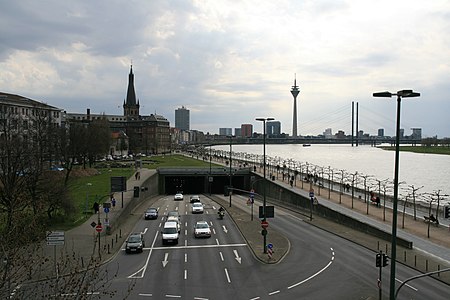Rheinufer Tunnel
Buildings and structures in DüsseldorfEuropean tunnel stubsGermany transport stubsNorth Rhine-Westphalia building and structure stubsRoad tunnels in Germany ... and 2 more
Transport in DüsseldorfTunnels completed in 1993

The Rheinufer Tunnel (German: Rheinufertunnel or "Rhine Bank Tunnel") is a road tunnel in Düsseldorf, Germany. The tunnel is part of the B1 German federal road. At 2 km (1.2 mi) long, it is the sixth longest inner city tunnel in Europe. The tunnel runs under the Rhine Promenade near the right hand bank of Rhine. The impressive southern entrance of the tunnel is marked by a tall building, the Düsseldorf Stadttor (city gate). The northern entrance is just south of the Oberkassel Bridge.
Excerpt from the Wikipedia article Rheinufer Tunnel (License: CC BY-SA 3.0, Authors, Images).Rheinufer Tunnel
Rheinufertunnel, Dusseldorf Altstadt (Stadtbezirk 1)
Geographical coordinates (GPS) Address Nearby Places Show on map
Geographical coordinates (GPS)
| Latitude | Longitude |
|---|---|
| N 51.230277777778 ° | E 6.7713888888889 ° |
Address
Sonnenuhr
Rheinufertunnel
40213 Dusseldorf, Altstadt (Stadtbezirk 1)
North Rhine-Westphalia, Germany
Open on Google Maps







